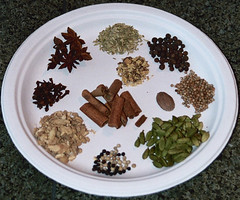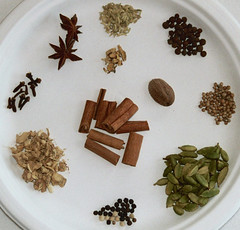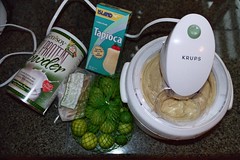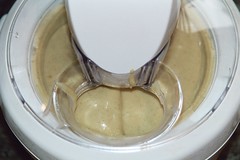 |
 |
 |
 |
 |
 |
We begin our tale of two applesauces by introducing our 3kg bag of apples, courtesy of our local Box Scheme (everything seems to be a scheme here in Scotland – it baffles us, as a scheme has quite a negative connotation in the US, but apparently is perfectly reasonable over here), which arrived at our door by accident. Yes, we’d ordered windfall organic apples — once. The second week they arrived, we were a little nonplussed. So, what does one do with 6.5 pounds of apples? Sauce presented itself, naturally!
We fortunately brought out our beloved manual peeler to the UK & turned the handle for quite some time, ending up with a bowl of cores, a pile of peelings, and a heaping pot full of apples. Adding some spices (ginger, cinnamon, nutmeg), a squeeze of lemon, and a bit of time and heat produced sauce! We prefer lovely, chunky sauce (we added about 4 granny smith apples, as well, to increase the chunk/tangy factor). But that’s not the end of the story, quite … as we also made sauce from the peels! If you look carefully at the little glass, you’ll be able to pick out the two different colors of sauce. The peels got whizzed up with the stick blender (yes, it does everything in this kitchen). Funnily enough, it kind of tasted like pear. Strange, but good.
~~~~~~~~~~~~~~~~~~~~~~~~~~~~~~~~
You might wonder what to do with so much applesauce (other than eat it out of the pot, warm, with a bit of freshly grated cinnamon and nutmeg, or as a snack with unsweetened soy yogurt and a drizzle of honey – yum).
Applesauce keeps pretty well, so don’t panic if you can’t think of two hundred things to do with it right off. We use ours in a variety of ways. Some vegans use applesauce as an egg substitute – 1/3 c. per egg called for. While we’ve never personally tried that, we do know that applesauce is a great substitute for added fat in baking. You can substitute up to 3/4 of the amount of butter with applesauce when making muffins — and voilá, your muffins or quick breads are a little less pound-friendly. And then, there’s applesauce cake… which is deadly dangerous and addictive…
Applesauce Spice Cake
This recipe is a fiddled-with-it adaptation of one from Vegetarian Times.
* 1/2 cup molasses (or treacle if you’re in the UK!**)
* 1 cup applesauce
* 1 tsp. freshly ground cinnamon
* 1/2 tsp. cloves
* 1 tsp. baking powder
* 1/4 tsp. baking soda
* 1 3/4 cup flour (I use whole wheat pastry flour)
* 2 Tbsp. ginger (I use grated fresh and candied as well – it’s a SPICE cake!)Combine the molasses and applesauce in a large bowl. Combine remaining ingredients and stir into the liquid. (If the batter seems very dry, add a little more applesauce or a little milk.) Bake in a nonstick or pan-sprayed 8*8-inch baking pan, in a 350 degree oven, for 30-45 minutes or until it tests done.
The optional ginger makes an amazingly good ginger bread. Another option is leaving out the ginger and adding 3 or 4 tablespoons of a good quality cocoa powder and a cup of semi-sweet chocolate chips to make a tasty but not very rich chocolate cake. If you use cocoa alone you might need to add extra sweetening, or really go all out on the frosting, but that depends on your taste.
We used the peels of the apples because… well, our parents weren’t old enough to go through the Depression (the most depressing thing that happened to them was probably JFK being shot and The Supremes splitting up), but both of us were brought up with parents who wanted us to clean our plates and not waste… so perfectly good apple peels being tossed, especially when we don’t have a compost pile here, made us a little sick. So, we knew we had to use them. One idea for using peels is to dip them in a little lemon juice to stop them from browning and then chop them and toss them with balsamic vinegar, stone ground mustard, and a little maple syrup as an accompaniment for salad of spinach, red onions, and mandarin orange slices. It’s very haute cuisine, yet simple.
Our first thought, because of the abundant pectin beneath the skin, was to make Apple Peel Jelly. Though we’ve heard it’s gorgeous and delicious, that really doesn’t taking advantage of the fiber in the peels, which is also so good and cholesterol-lowering, so we couldn’t use all of them that way. We came up with making a sauce from the peels – ’cause our immersion blender can do anything. And it turns out we were right not to toss them anyway — Cornell University published a study this last spring about the cancer-preventative properties found in apple peels. Score one for us!
**Treacle is a real pain — because we can’t find any unsulphured molasses, we’re using something called ‘molasses sugar’ which is dark, dark, DARK brown, dense and moist sugar. We just add a little extra applesauce to compensate for the moisture and go on. We’re learning to do that a lot here!


















 My friend
My friend